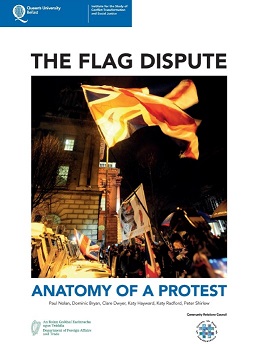 Today saw the publication of a report by researchers from the Institute for the Study of Conflict Transformation and Social Justice at Queen’s University Belfast, ‘The Flag Dispute: Anatomy of a Protest.’
Today saw the publication of a report by researchers from the Institute for the Study of Conflict Transformation and Social Justice at Queen’s University Belfast, ‘The Flag Dispute: Anatomy of a Protest.’
It offers two key recommendations:
- A review of the outcomes of single identity work, coupled with additional programmes in loyalist areas that promote engagement with people from different backgrounds.
- In the absence of leadership from political parties, reconciliation bodies and civil society organisations should articulate a ‘people’s peace plan’ with ‘a clear vision of how reconciliation can be achieved.’
The launch of the report coincides with the second anniversary of the vote in City Hall which restricted the flying of the union flag to designated days. The full 145-page document ‘looks at the origins of the protest, the way in which it developed and spread, the tactics of the police in managing the demonstrations, the arrests and sentencing of protestors, and the political reactions. It also considers the legacy of the flag protest for politics, society, the economy and community relations in Northern Ireland.’
The authors of the report are Paul Nolan, Dominic Bryan, Clare Dwyer, Katy Hayward, Katy Radford and Peter Shirlow. The research was funded by the Community Relations Council and the Irish Department of Foreign Affairs and Trade.
According to the Introduction to the ten-page summary report, the study involved ‘interviews with approximately 60 people (and conversations with hundreds), a comprehensive trawl of print and broadcast media, an examination of social media, the extensive use of PSNI records, and the creation of a detailed data base of all events during the period December 2012 and March 2013.’
I’ve not yet had time to carefully read the entire report, which will be available in print form in January.
But what struck me the most was the report’s analysis of the impact of the flag protests on community relations. This is best described in sections 9.3 and 9.4 of the summary report:
‘We suggest that there are two key facts to be considered. One is that within the loyalist community the most frequently voiced concern is that ‘no one listens to us’. Any long-term planning of community relations work must attend to this key reality. The other is that the desire to be heard is not accompanied by any desire to listen. We have found a striking lack of interest in the concerns of the nationalist neighbour, or any willingness to concede that nationalism has also had to make compromises during the peace process.
In this context the retreat into ‘single identity work’ may represent a step backwards. The desire for ethnic affiliation and the reinforcement of national identity may not assist the process of reconciliation. Indeed the evidence suggests that the more that a sense of national identity increases, the less interest there is in understanding other perspectives.’
The report also includes the perspectives of the protesters, including direct quotes from interviews. These effectively convey the emotions involved and underline the challenges for a conclusion of the protests. Take these examples (p. 96-97):
In this society you are discriminated against if you’re Protestant. There’s no ifs or buts around it. It’s a fact. (21 year old male protestor)
We feel we have no rights. Our rights are being stripped from us daily. (70 year old female protestor)
And this conversation with a 19 year old interviewee from North Belfast (p. 97-98):
The Good Friday Agreement has not materialised. It has not brought the promises that it said it would. I obviously didn’t sign the Good Friday Agreement – I certainly wouldn’t have signed it. I certainly wouldn’t have recognised the Patten Reforms.
Interviewer: What age were you in 1998?
I was 4.
Interviewer: So you have grown up in what everyone has told you is Peace. Would you see this as Peace time?
Peace? I haven’t grown up in Peace. You can’t live in a peaceful society when your national territory is constantly under threat. When your identity is constantly under threat and when your life is subsequently under threat.
Interviewer: Do you see your British identity being eroded?
It is being eroded and it’s a callous attempt by Sinn Féin to sterilise Northern Ireland and to show the Republican movement and their grassroots support that there is no longer a British presence in the 6 counties.
At the same time the report details some of the consequences for youth who did take part in the protest. As a female community worker from North Belfast said (p. 89):
we have a young generation of kids in prison because of the flag protest … Now most of the ones that I have spoken to that were criminalised are saying to me, “The flag wasn’t worth it. … I was unemployed before, but even more unemployable now.” These are people who’d have had careers in front of them, were ready to get married and have babies; [they] have now thrown away their lives because of what happened in that spur of the moment.
What resulted? If the flag protest were to be judged in terms of its declared objective then it could be shown to have had zero success. The flagpole at Belfast City Hall remains bare for 347 days a year. The celebrity leaders have faded back into obscurity. Their electoral mettle was tested in the May 2014 elections when the ‘parties of the protest’, suffered meltdown – in fact, the meltdown occurred even before the elections took place. Willie Frazer’s Protestant Coalition fell apart almost instantly, while Jamie Bryson’s attempt to raise £5,000 to run as an independent ended when with revelation that he had only succeeded in raising £165.
But the deeper, underlying issues behind the flag protests very much remain – along with many difficult questions.
Can politicians show any leadership on these matters, especially given the opportunity of the current talks process? Or can we only hope that a ‘people’s peace plan’ to help address those issues will actually materialise? Who would organise it? And how would loyalist alienation be addressed?
“… a piece of creative thinking resulted in the adoption of the flax motif, now accepted by all sides as an elegant symbol for the devolved parliament.
“This is the type of creative thinking that will be required in the future. There will be other symbolic issues which could ignite similar passions. The politicians and civil society have a duty to work together to make sure that that they do not. That means they must do more than simply express grievances; instead they must work to find solutions.”

Gladys is a Professor of Sociology at Queen’s University Belfast and a member of the Royal Irish Academy.
She is also a runner who has represented Ireland and Northern Ireland. She blogs on religion and politics at gladysganiel.com
Discover more from Slugger O'Toole
Subscribe to get the latest posts to your email.